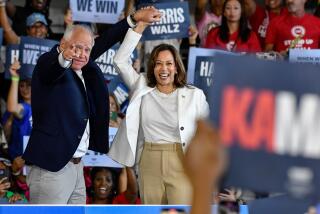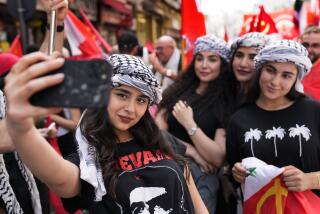Op-Ed: How Labor Day sprang from state violence
Labor Day is an oddly apolitical affair in the United States. Most people treat it primarily as an excuse to barbecue with the family. If we pay homage to workers movements at all, it’s usually to celebrate the existence of weekends. But Labor Day sprang from state violence.
In 1894, employees at the Pullman train car factory outside Chicago went on strike for better wages and conditions. After demonstrations spread to the nation’s railroads, U.S. marshals and the military were called in to crush the strike, leaving 30 dead. Anger at the violent crackdown led President Cleveland to try to appease the working class by declaring a federal holiday.
We’ve forgotten the brutal clashes that went into creating the eight-hour workday and the weekend [and that] organizers faced constant police surveillance.
He chose the first Monday in September, rather than May 1 — already celebrated around the world as International Workers Day — because the latter date was too potent a reminder of an even more brutal crackdown on labor agitators.
On May 1, 1886, labor organizers called general strikes across the country, demanding that employers institute an eight-hour workday without a reduction in pay. In Chicago, the strikes spread like wildfire, even to previously unorganized workplaces such as McCormick Reaper Works, where on May 3 strikers were shot by Chicago police. In response, Chicago’s labor community called a rally at the Haymarket for the next evening.
The rally was peaceful; Chicago’s mayor attended and remarked that everything seemed fine before he left. But then police moved in to break up the rally, and someone threw a bomb. Police opened fire; three civilians and seven officers were killed, possibly by friendly fire. In the absence of any evidence as to who threw the bomb, the anarchist speakers were still accused and convicted of conspiracy. Four of them were executed.
Around the world, workers and then national governments adopted May 1 as a day to commemorate the Haymarket affair. Historian James Green, who died this year, wrote: “No other event in American history has exerted such a hold on the imaginations of people in other lands, especially on the minds of working people in Europe and the Latin world, where the ‘martyrs of Chicago’ were annually recalled in the iconography of May Day.”
But on Labor Day in the U.S., we ignore this violent history. It’s almost like it never happened. We’ve forgotten the brutal clashes that went into creating the eight-hour workday and the weekend; we’ve forgotten that labor organizers faced constant police surveillance. This collective forgetting may explain why we often pretend that police violence and working conditions have nothing to do with each other, even though the two threads have been linked for more than a century.
The movement for black lives is an exception to the rule. Its organizers have compared the slow violence of poverty, of underfunded schools and low-wage work or underground-economy work — selling loose cigarettes like Eric Garner, or CDs like Alton Sterling — to the quick violence of the police officer’s bullet. Activists point out that the same force that extracts fines and fees from arrestees also shows up to rein in strikes more than 130 years after the events at Haymarket. They understand, as Ferguson protester Kennard Williams told me, that “every facet of the movement is interconnected.”
The young black and Latino workers who make up the backbone of the Fight for $15 campaign understand the connections as well. In St. Louis, they held “die-ins” that evoked not only the amount of time that Michael Brown’s body lay in the street after a police officer shot him in Ferguson, but also the 1930s sit-down strikes against General Motors. Fast-food-restaurant strikers across the country chanted “Hands up, don’t shoot” when police arrived to protect their stores from their protests. In Chicago, Fight for $15 organizers made the history of Haymarket part of their struggle, visiting the memorial to the executed men.
Not everyone in the labor movement gets that police violence pertains to their cause; they’d rather limit their activism to negotiating better deals on a business-by-business or industry-by-industry basis. When the United Federation of Teachers joined a march for Garner, who was killed by a New York Police Department officer in the summer of 2014, a group of teachers reacted by wearing “We Support the NYPD” shirts to school. When graduate student members of the United Auto Workers called for the AFL-CIO to disaffiliate from police unions, their calls went unheeded.
Labor struggles to find its role in the movement for black lives, but the economic inequality they are fighting has always been shaped by police and the state.
Sarah Jaffe is the author of “Necessary Trouble: Americans in Revolt.”
Follow the Opinion section on Twitter @latimesopinion and Facebook
MORE FROM OPINION
Killing the TPP: Not a long-term win for U.S. labor
Why firing bad teachers isn’t nearly as important as creating good ones
The Labor Day wage picture in California. (Conclusion: learn how to deal blackjack)
More to Read
A cure for the common opinion
Get thought-provoking perspectives with our weekly newsletter.
You may occasionally receive promotional content from the Los Angeles Times.










